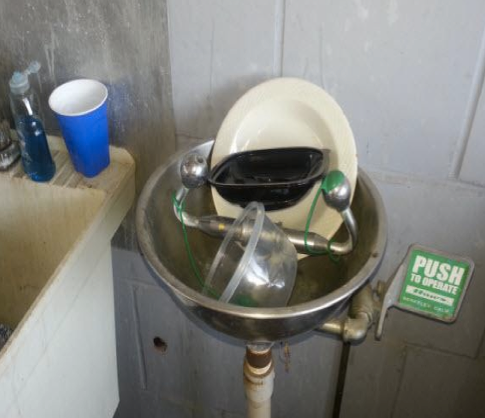Spot The Safety Violation: Only Use Safety Equipment for Safety Purposes

Is storing dirty dishes a proper use for an eyewash station’

Multitasking can be perfectly acceptable in the workplace. But some equipment is intended for one use and one use only. And using this equipment for other purposes can, in fact, impede use of it for its intended purpose. That’s especially true for safety equipment.
This picture from the US Naval Safety Center depicts an eyewash station in a naval hospital. It’s good that the hospital has this station available should workers get something in their eyes. But also using it to store dirty dishes is inappropriate and can delay a worker’s being able to use the station as intended to rinse his eyes out in an emergency’and even result in serious injury.
So make sure that workers understand that safety equipment, such as eyewash stations, should only be used for their intended purposes.
10 Eyewash Station Best Practices
Here are 10 eyewash station best practices that you should implement in your workplace:
1. Keep the doors open. Don’t place an emergency eyewash station behind a closed or locked door. Although the station may be used infrequently, remember that when it’s needed, someone’s vision is on the line’and every second counts.
2. Don’t hang the station at an angle. Doing so can interfere with the proper flow of flushing fluid and may force an injured person to stand in an uncomfortable position to flush their eyes properly.
3. Don’t block access. Avoid storing anything underneath, around or in front of an eyewash station, which can block an injured worker’s ability to reach or stand comfortably at the station.
4. Watch the fluid’s temperature. Don’t allow the flushing fluid to become too hot or too cold. Storing flushing fluid in extremely hot or cold environments can cause its temperature to rise or fall outside of standards for tepid water. And flushing eyes with scalding or ice-cold solution can cause further damage to an already compromised eye.
5. Fill the station properly. Avoid mistakes when mixing flushing fluid. For example, the OHS laws may require the station to be filled with flushing fluid or the pre-packaged fluid provided by the manufacturer. Always prepare this fluid according to the manufacturer’s instructions.
6. Clean thoroughly after use. Don’t forget to clean, disinfect, rinse and completely dry the station after each activation, including its hoses, nozzles and nozzle covers (but not the sealed-fluid cartridges). Any lingering cleaning chemicals or particles may harm the next user’s eyes. When the wrong chemicals mix, the fluid may turn brown or another color and colored fluid should be used.
7. Don’t cover the station. Don’t place a plastic bag or other makeshift cover over the station to keep out dust or particles, which can hinder an injured person’s ability to properly activate the unit in a single motion and start the flow in one second or less.
8. Mind the shelf life. Avoid using expired flushing fluid. Like any standing water, eyewash fluid can grow bacteria that may be harmful to eyes. Be sure that someone’s responsible for checking expiration dates and refilling/replacing expired fluid according to the manufacturer’s guidelines, such as every two to three years for sealed-fluid cartridges and bottles. In addition, plumbed stations should generally be flushed weekly and tank-style fluid stations every three to six months.
9. Install the station correctly. Don’t install an eyewash station without carefully following the manufacturer’s instructions. Stations vary and have precise installation instructions to ensure proper performance, including installation height, the rate of fluid flow, required spray pattern and much more.
10. Don’t alter or tamper with the station. Again, the manufacturer’s instructions are the only ones that should be followed. Don’t try to re-route hoses, change nozzles or otherwise compromise the station’s performance.
And for more first aid related information, go to the OHS Insider for: